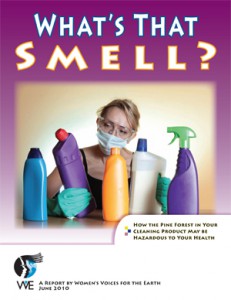Chemicals of Concern Commonly Found in Fragrance Used in Cleaning Products
 Allergens: Numerous fragrance ingredients, even those which are natural compounds found in lavender oil and lemon oil, for example, can lead to allergies in sensitive persons. Exposure to allergens in fragrance through inhalation or absorption through the skin can cause skin and eye irritation, as well as more serious impacts such as breathing problems.
Allergens: Numerous fragrance ingredients, even those which are natural compounds found in lavender oil and lemon oil, for example, can lead to allergies in sensitive persons. Exposure to allergens in fragrance through inhalation or absorption through the skin can cause skin and eye irritation, as well as more serious impacts such as breathing problems.
Synthetic Musks: Synthetic musks are man-made chemicals produced to replicate musk scents originally obtained from musk deer and musk ox. The most commonly used synthetic musks are the polycyclic musks, galaxolide and tonalide, and two types of nitro musks, musk xylene and musk ketone. Research indicates that synthetic musks don’t break down in the environment, can accumulate in our bodies, are potential hormone disruptors and may break down the body’s defenses against other toxic chemical exposure. Learn which companies are still using these chemicals.
Phthalates: Phthalates are a class of chemicals used in fragrance that do not contribute a scent, like musks or plant essences do, but rather act as solvents and carriers for those chemicals that create the scent in a fragrance. Phthalates have been shown to cause reproductive and developmental harm in laboratory animals, and are linked to similar impacts in humans.
Imagine yourself in a flower garden, a shady pine forest, a lemon grove on a summer day or on a tropical island at sunset. Peaceful, joyous images come to mind for most of us—and this is exactly what the manufacturers of many cleaning products aim to deliver to your very own home!
Cleaning product manufacturers anticipate and respond to the needs and desires of their customers, predominantly women, who look for products that enhance the experience of cleaning and add a sensory pleasure to their homes. But most of us are unaware that thousands of synthetic chemicals are used to create modern day fragrances for our products, and that some of these chemicals have been linked to health impacts ranging from eye and skin irritation to hormone imbalance and increased risk of breast cancer.
Furthermore, these ingredients are kept secret—the vast majority of manufacturers currently are not disclosing fragrance ingredients on websites or on the product label, and these ingredients are frequently claimed as confidential business information. This means that consumers are unable to avoid certain chemicals even if they desired to do so. The only current solution to reducing exposure to chemicals of concern is to avoid fragranced products all together, and this is simply an unfair choice.
What’s that Smell? is designed to shed some light on the associated human health impacts of common fragrance ingredients in cleaning products. Specifically, it presents the current scientific findings on allergens linked to eye and skin irritation and breathing problems, synthetic musks linked to hormone disruption and potential increased risk of cancer, and phthalates linked to reproductive and developmental harm.
This report also highlights the need for additional studies to better understand the impacts that exposure to these chemicals have on human health, particularly during critical stages of development such as pregnancy and infancy.
What’s that Smell? is intended to provide consumers with alternatives for reducing their exposure to potentially harmful chemicals in fragranced cleaning products and to offer some policy solutions for protecting public health in the long term.
Download the full report, What’s That Smell?
Alternatives to Fragranced Cleaning Products
How Did That Pine Forest Get in My Cleaner?
WVE’s first-ever comic!


